Möchten Sie Ihr WordPress-Passwort mit phpMyAdmin zurücksetzen?
Wenn Sie Ihr WordPress-Passwort nicht zurücksetzen können, gibt es eine Möglichkeit, es direkt in Ihrer WordPress-Datenbank mit phpMyAdmin zurückzusetzen.
In diesem Artikel zeigen wir Ihnen, wie Sie ein WordPress-Passwort einfach über phpMyAdmin zurücksetzen können.
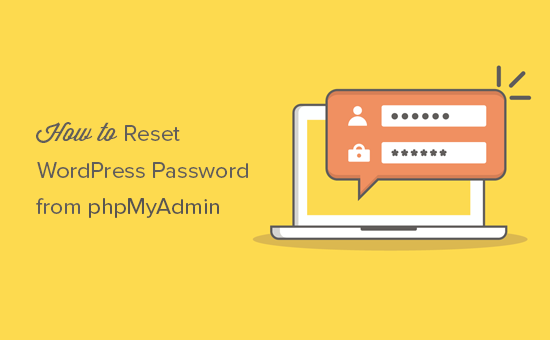
Warum ein WordPress-Passwort von phpMyAdmin aus zurücksetzen?
WordPress macht es super einfach, ein verlorenes Passwort wiederherzustellen.
Gehen Sie einfach zum Anmeldebildschirm Ihrer WordPress-Website und klicken Sie auf den Link „Passwort vergessen?“.
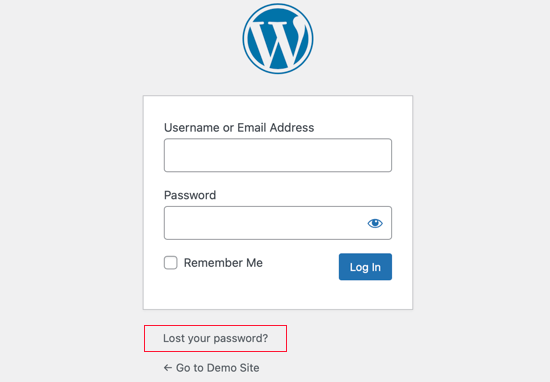
Wenn Sie auf den Link klicken, werden Sie auf die Seite zum Zurücksetzen des Passworts weitergeleitet. Sobald Sie Ihren Benutzernamen oder Ihre E-Mail-Adresse eingeben, sendet WordPress einen Link zum Zurücksetzen des Passworts an die entsprechende E-Mail-Adresse.
Wenn Sie jedoch keinen Zugriff auf diese E-Mail-Adresse haben oder Ihre WordPress-Website keine E-Mail sendet, können Sie Ihr Passwort nicht zurücksetzen.
In einer solchen Situation müssen Sie Ihr WordPress-Passwort direkt in der Datenbank zurücksetzen. Am einfachsten geht das mit phpMyAdmin.
Sehen wir uns nun an, wie Sie ein WordPress-Passwort von phpMyAdmin aus zurücksetzen können.
Wie man ein WordPress-Passwort von phpMyAdmin aus zurücksetzt
Wenn Sie sich das Video-Tutorial nicht ansehen möchten, können Sie die Textversion weiter unten lesen.
Zunächst müssen Sie sich in das cPanel-Dashboard Ihres WordPress-Hosting-Kontos einloggen. Als nächstes müssen Sie zum Abschnitt Datenbanken navigieren, wo Sie auf das Symbol phpMyAdmin klicken können.
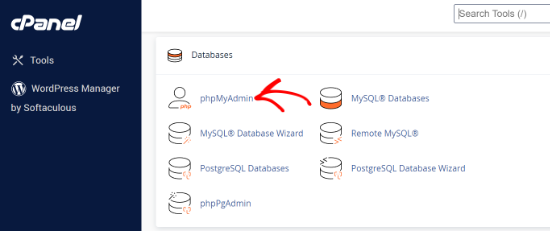
Dadurch wird die phpMyAdmin-Anwendung gestartet.
Hier müssen Sie Ihre WordPress-Datenbank im linken Bereich auswählen.
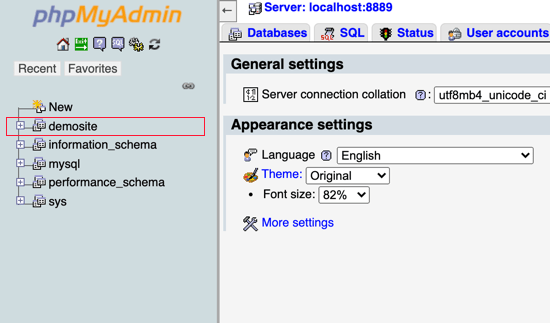
Sie sehen nun die Liste der Tabellen in Ihrer WordPress-Datenbank.
Suchen Sie in dieser Liste nach der Tabelle wp_users und klicken Sie auf den Link „Durchsuchen“ daneben.
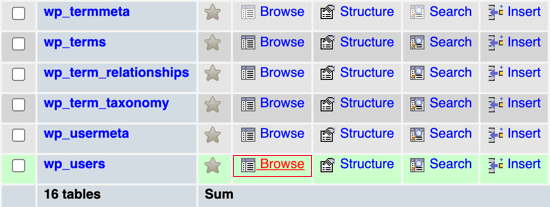
Hinweis: Die Tabellennamen in Ihrer WordPress-Datenbank haben möglicherweise ein anderes Präfix als das, das wir in unserem Bildschirmfoto zeigen. Das Ändern der Tabellenpräfixe kann die Sicherheit Ihrer WordPress-Website verbessern.
Sie sehen nun die Zeilen in Ihrer WordPress-Benutzertabelle. Klicken Sie auf die Schaltfläche Bearbeiten neben dem Benutzernamen, dessen Passwort Sie ändern möchten.
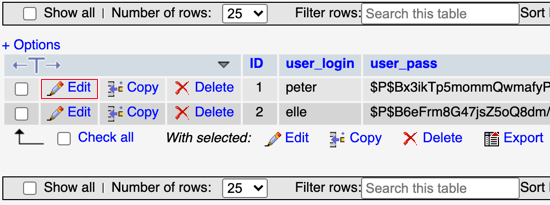
PhpMyAdmin zeigt Ihnen ein Formular mit allen Benutzerinformationsfeldern.
Sie müssen den Wert im Feld user_pass löschen und ihn durch Ihr neues Passwort ersetzen. Wählen Sie in der Spalte „Funktion“ die Option „MD5“ aus dem Dropdown-Menü und klicken Sie dann auf die Schaltfläche „Los“ am unteren Rand des Formulars.
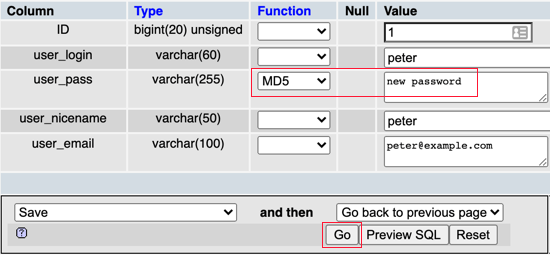
Ihr Passwort wird mit einem MD5-Hash verschlüsselt und in der Datenbank gespeichert.
Herzlichen Glückwunsch! Sie haben Ihr WordPress-Passwort mit phpMyAdmin erfolgreich geändert.
Einige von Ihnen werden sich vielleicht fragen, warum wir den MD5-Hash für die Verschlüsselung des Passworts gewählt haben. WordPress hat früher MD5-Hash zur Verschlüsselung von Passwörtern verwendet, aber seit WordPress 2.5 werden stärkere Verschlüsselungstechnologien eingesetzt.
WordPress erkennt jedoch weiterhin MD5, um Abwärtskompatibilität zu gewährleisten. Sobald Sie sich mit einer als MD5-Hash gespeicherten Kennwortzeichenfolge anmelden, ändert WordPress diese automatisch, um die neueren Verschlüsselungsalgorithmen zu verwenden.
Expertenanleitungen zu Passwörtern in WordPress
Nachdem Sie nun wissen, wie Sie ein WordPress-Passwort über phpMyAdmin zurücksetzen können, möchten Sie vielleicht noch einige andere Artikel zum Thema Passwörter in WordPress lesen.
- Wie Sie Ihr Passwort in WordPress ändern (Anleitung für Anfänger)
- Passwörter für alle Benutzer in WordPress zurücksetzen
- Anpassen der WordPress-Seite „Passwort zurücksetzen
- Wie man Benutzer dazu zwingt, Passwörter in WordPress zu ändern – Passwort ablaufen lassen
- Passwort vergessen? Wie man ein verlorenes Passwort in WordPress wiederherstellt
- Erzwingen starker Passwörter für Benutzer in WordPress
- Hinzufügen der Zwei-Faktor-Authentifizierung in WordPress (kostenlose Methode)
- Verstecken/Anzeigen von Passwörtern auf dem WordPress-Anmeldebildschirm zulassen
- Einfache und sichere Verwaltung von Passwörtern (Anleitung für Anfänger)
Wir hoffen, dass diese Anleitung Ihnen geholfen hat, zu lernen, wie man ein WordPress-Passwort über phpMyAdmin zurücksetzt. Vielleicht interessiert Sie auch unser ultimativer Schritt-für-Schritt-Leitfaden für WordPress-Sicherheit, um Ihre WordPress-Website sicher zu halten, oder unsere Expertenauswahl an Must-Have-Plugins.
Wenn Ihnen dieser Artikel gefallen hat, dann abonnieren Sie bitte unseren YouTube-Kanal für WordPress-Videotutorials. Sie können uns auch auf Twitter und Facebook finden.




Syed Balkhi says
Hey WPBeginner readers,
Did you know you can win exciting prizes by commenting on WPBeginner?
Every month, our top blog commenters will win HUGE rewards, including premium WordPress plugin licenses and cash prizes.
You can get more details about the contest from here.
Start sharing your thoughts below to stand a chance to win!
Prescott Chartier says
I’ve tried this several times and each time it still says the password is incorrect, and yes I have the correct database.
WPBeginner Support says
The next thing to check would be that the MD5 action is properly going through in your database or if it gives you an error.
Admin
Moinuddin Waheed says
Changing password by clicking lost or forget password and then getting an email is an easy step.
Using phpmyadmin for changing password is a bit developer oriented.
I have used while developing sites from local host by flywheel but I fear doing for the live server.
Do we have the same encryption after changing password as it was before or it is simply the hard coded text that we typed in as password?
WPBeginner Support says
If you are using the phpMyAdmin method you would want to put in your password normally and in the function dropdown you would set it to MD5 to have the password be the text you placed in the field.
Admin
Laxman says
Thank You very much…
WPBeginner Support says
You’re welcome
Admin
Branson says
Hi,
I have just tried to reset my password with the MD5 method you suggested, but it didn’t work. I tried like 5 times and every time I tried to login into my website it would say incorrect password. What’s wrong?
Thanks in advance.
WPBeginner Support says
If you have more than one WordPress installation on your hosting provider, ensure you are editing the correct database and ensure you apply the changes in the database for the most common reasons.
Admin
Stem says
Hello,
I tried to reset my password using this method, but it’s showing this error „Error: The username user is not registered on this site. If you are unsure of your username, try your email address instead.“
WPBeginner Support says
That would normally mean your username is not on the site, you would want to ensure are logging in with the correct username or email address. The steps in this article should not affect your username or email.
Admin
Brett says
MD5 pushed it through. Thank you!
WPBeginner Support says
You’re welcome! Glad our guide was helpful
Admin
blossominglotus says
This method is not working for me. I even tried updating the password using raw SQL. It does change the password but I still cannot log in with the new password.
WPBeginner Support says
If this method is not working then we would recommend reaching out to your hosting provider and/or checking that you are editing the correct database on your hosting provider if you have more than one database.
Admin
Guillaume Frasca says
Hi, I followed your advice, but when I click on Go, I have the #1142 error message „UPDATE command denied to user ’scienceisa431’@’@XX.XX.XX.X‘ for table ‚mod597_users‘
Is there a way around this?
WPBeginner Support says
Your user may not have proper access on your hosting environment, if you reach out to your hosting provider they should be able to assist!
Admin
James Wallis says
Saved my skin with this–thank you so much.
WPBeginner Support says
Glad our guide was helpful!
Admin
Joseph says
Thanks for the good job
I was able to locate and change my WordPress details with this tutorial
WPBeginner Support says
Glad our guide could help!
Admin
Randy says
I tried this and I got a white screen on my website. Please help
WPBeginner Support says
Changing your password shouldn’t cause that specific issue, there is a good chance a plugin may have had a conflict. You would want to follow our guide below for how to fix the white screen error:
https://www.wpbeginner.com/wp-tutorials/how-to-fix-the-wordpress-white-screen-of-death/
Admin
Syed Waris says
Thank you so much.
The article was very helpful for me.
WPBeginner Support says
Glad our guide was helpful!
Admin
NS says
Thanks! The „MD5“ encryption step is what I was missing when I tried to reset. Then I came across your article and tried it and it worked! You just saved me hours and hours of time and a potentially angry client.
aisha says
I tried this but didn’t work. Need help
WPBeginner Support says
If your changes are not staying, you would likely want to check with your hosting provider to ensure you’re not running into a security tool blocking your change. Another common issue would be if you have a staging site or an old database for a previous site so you would want to ensure you are changing the information for your correct site.
Admin
Altuğ G. says
This didn’t work for me
WPBeginner Support says
It would depend on what part didn’t work. The most common reasons would be if you did not save your changes or did not convert to MD5
Admin
Pakodev says
Thanks! It worked.
WPBeginner Support says
Glad our guide was able to help
Admin
Arsène says
It worked, thank you very much
WPBeginner Support says
Glad our guide could help
Admin
Aikya Dasgupta says
Thank you very much. This worked for me and I am now able to access my WordPress dashboard.
WPBeginner Support says
Glad our guide was helpful
Admin
John says
Perfect – saved me from a big issue.. thanks! Now, about getting those WP system emails working again…………….!
WPBeginner Support says
If you’re not receiving the emails, we would recommend setting up SMTP on your site:
https://www.wpbeginner.com/plugins/how-to-send-email-in-wordpress-using-the-gmail-smtp-server/
Admin
Tayyab Shafique says
it was really helpful.
Thanks
WPBeginner Support says
You’re welcome
Admin
Saad says
thanks a lot for saving my day …
WPBeginner Support says
You’re welcome
Admin
Anita says
Thank you, this saved me a headache
WPBeginner Support says
Glad our guide was helpful
Admin
Elias says
You’re a genius. Thank you
WPBeginner Support says
You’re welcome
Admin
jackie says
REALLY helpful. I’ve been struggling for weeks and now i can finally log in again! thanks a lot!
WPBeginner Support says
You’re welcome, glad our guide was helpful
Admin
Robin B says
So, so helpful. Thanks so much!
WPBeginner Support says
You’re welcome
Admin
Chidi Ejikeugwu says
why did you recommend to use MD5 when changing password?
WPBeginner Support says
That is what WordPress uses for passwords by default
Admin
japsimran singh says
Thank You Buddy.
It really helped.
WPBeginner Support says
Glad our article could help
Admin
banson says
Thank you problem Solved
WPBeginner Support says
Glad our guide was helpful
Admin
Nthtuko Mbhele says
Thank you so much, thank you, thank you
WPBeginner Support says
You’re welcome, glad our guide was helpful
Admin
Premier says
Thank you! Solved my problem!
WPBeginner Support says
Glad our guide was able to help
Admin
Yann says
Worked wonders, thanks!
WPBeginner Support says
You’re welcome, glad our guide was able to help
Admin
Marco says
thank you!!!!!!
WPBeginner Support says
You’re welcome
Admin
Anand says
Did not work for me.
WPBeginner Support says
You may want to ensure you set the password to MD5 and that you are editing the correct user file if you have multiple WordPress sites or users
Admin
Pranoy says
very very thank you
big headache solved
WPBeginner Support says
Glad our guide could be helpful
Admin
Urs Keller says
You did super great job. I could reset my pw. Thank you!
WPBeginner Support says
You’re welcome, glad we could help
Admin
Taylor says
I have followed these steps and the password was generated however, whenever I put in the password it still says it is incorrect.
Any help you can provide ?
WPBeginner Support says
You would want to double-check that you encrypted the password using MD5 as the most common reason
Admin
Cattel says
Direct explanation! Thanks!
WPBeginner Support says
You’re welcome
Admin
Hazel Pan says
Thank you for this noob-friendly guide! I was able to understand how to fix my issue right away. It also helped that I had awesome support from my hosting provider, Namecheap.
WPBeginner Support says
Glad our guide could be helpful
Admin
Terry says
Thank you so much for this article, it helped.
WPBeginner Support says
Glad our article was helpful
Admin
Umar Gondal says
May Allah bless you with eman. This article helped me to reset password of my website. Very informative article
WPBeginner Support says
Glad our article could be helpful
Admin
Ajit Kumar says
The email could not be sent. Possible reason: your host may have disabled the mail() function.
error shows
WPBeginner Support says
If you have that error on your site, you would want to start by reaching out to your hosting provider.
Admin
George says
Great article, I can see how this „can“ work, but didn’t work for us either!!!!! We have access to the registrar, access to the domain and web hosting, full access to file manager, phpMyAdmin and the Installatron.
Followed your instructions to the T, didn’t work. We even changed the email in the email field. Its like the script didn’t update.
WPBeginner Support says
If this method didn’t work then you likely need to reach out to your hosting provider and your host should be able to assist in fixing this issue.
Admin
Donny says
Really helpful, thanks a lot.
WPBeginner Support says
You’re welcome
Admin
zorax says
Thank you, it was really helpful!
WPBeginner Support says
You’re welcome
Admin
Van says
This didn’t work for me. I’ve tried changing my password via my profile in WP Admin and using this technique; neither worked. WordPress 5 bug?
WPBeginner Support says
You may want to clear your cache on your site and browser and check with your hosting provider that they are not preventing changes to your site’s database.
Admin
Ammar Falak says
It didn’t work for us. I am still locked out of my WordPress Account. Please help!
WPBeginner Support says
If this method does not work, if you reach out to your hosting provider they should be able to help you log back into your site.
Admin
Sanyukta Khot says
Thank you for a very useful article! Saved me a lot of time!
WPBeginner Support says
You’re welcome
Admin
Dee says
Awesome!! Thanks so much for the valuable information.
Please continue to help us newbies…
WPBeginner Support says
Glad our articles are helpful
Admin
lordhunos says
Wow, it works! You made my day! Thank you very much!
WPBeginner Support says
Glad our article could help
Admin
Boitumelo says
This was very very helpful.
Thank you very much
WPBeginner Support says
Glad it was helpful
Admin